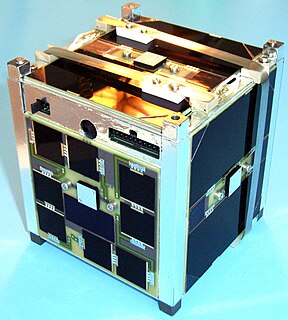
This article outlines notable events occurring in 2005 in spaceflight, including major launches and EVAs. 2005 saw Iran launch its first satellite.

1971 saw the last three known deaths of cosmonauts of the Soviet space program and the only deaths in space. Their mission was to man humanity's first space station. The experimental bay door failed to separate so the first crew failed to dock and second crew were killed on re-entry. 1971 also saw the launch of the first and only British satellite on top of a British rocket after that success the program was cancelled.

The Soyuz-FG launch vehicle was an improved version of the Soyuz-U from the R-7 family of rockets, designed and constructed by TsSKB-Progress in Samara, Russia. Guidance, navigation, and control system was developed and manufactured by "Polisvit" Special Design Bureau.
Orlets was a series of Russian, and previously Soviet photoreconnaissance satellites derived from and intended to augment the Yantar series of spacecraft. Ten satellites were launched between 1989 and 2006; eight in the Orlets-1 configuration and two in the Orlets-2 configuration.
Kosmos 245, known before launch as DS-P1-Yu No.16, was a Soviet satellite which was used as a radar calibration target for tests of anti-ballistic missiles. It was built by the Yuzhnoye Design Bureau, and launched in 1968 as part of the Dnepropetrovsk Sputnik programme. It had a mass of 325 kilograms (717 lb).
Kosmos 277, known before launch as DS-P1-Yu No.20, was a Soviet satellite which was used as a radar calibration target for tests of anti-ballistic missiles. It was a 325-kilogram (717 lb) spacecraft, which was built by the Yuzhnoye Design Bureau, and launched in 1969 as part of the Dnepropetrovsk Sputnik programme.
Kosmos 285, known before launch as DS-P1-Yu No.24, was a Soviet satellite which was used as a radar calibration target for tests of anti-ballistic missiles. It was a 250-kilogram (550 lb) spacecraft, which was built by the Yuzhnoye Design Bureau, and launched in 1969 as part of the Dnepropetrovsk Sputnik programme.
Kosmos 380, known before launch as DS-P1-Yu No.26, was a Soviet satellite which was launched in 1970 as part of the Dnepropetrovsk Sputnik programme. It was a 250-kilogram (550 lb) spacecraft, which was built by the Yuzhnoye Design Bureau, and was used as a radar calibration target for anti-ballistic missile tests.
Samos 2 was an American reconnaissance satellite launched in 1961 as part of the Samos program. It was an early electro-optical reconnaissance spacecraft, meaning that it transmitted images to receiving stations on Earth rather than returning them in a film capsule. Samos 2 was a Samos-E1 spacecraft, based on an Agena-A.

BeeSat-1 or Berlin Experimental and Educational Satellite 1, is a German satellite operated by the Technical University of Berlin. The spacecraft is a single unit CubeSat, which was designed to test systems intended for use on future spacecraft, including a new design of reaction wheel. It has also been used for amateur radio, and is equipped with a small camera.
USA-184, also known as NRO Launch 22 or NROL-22, is an American signals intelligence satellite, operated by the National Reconnaissance Office. Launched in 2006, it has been identified as the first in a new series of satellites which are replacing the earlier Trumpet spacecraft.

USA-232, also known as GPS IIF-2, and GPS SVN-63, is an American navigation satellite which forms part of the Global Positioning System. It was the second of twelve Block IIF satellites to be launched.

USA-248, also known as GPS IIF-5, GPS SVN-64 and NAVSTAR 69, is an American navigation satellite which forms part of the Global Positioning System. It was the fifth of twelve Block IIF satellites to be launched.

USA-251, also known as GPS IIF-6, GPS SVN-67 and NAVSTAR 70, is an American navigation satellite which forms part of the Global Positioning System. It was the sixth of twelve Block IIF satellites to be launched.

USA-256, also known as GPS IIF-7, GPS SVN-68 and NAVSTAR 71, is an American navigation satellite which forms part of the Global Positioning System. It was the seventh of twelve Block IIF satellites to be launched.

Progress 8, was a Soviet uncrewed Progress cargo spacecraft which was launched in 1980 to resupply the Salyut 6 space station.
The Surveillance Calibration satellites were a series of radar calibration satellites for the Naval Space Surveillance radar system. They were launched in the 1960s.
This page is based on this
Wikipedia article Text is available under the
CC BY-SA 4.0 license; additional terms may apply.
Images, videos and audio are available under their respective licenses.






